Pacanów
Pacanów [paˈt͡sanuf], sometimes referred to as the European Capital of Fable, is a town in Busko County, Świętokrzyskie Voivodeship in south-central Poland. It is the seat of Gmina Pacanów. It had a population of 1137 in 2003. The village's sołtys is Jan Łuszcz and the wójt is Wiesław Skop. In modern times the village is partly noted for its connection to the fictional character Koziołek Matołek. It lies in historic Lesser Poland, approximately 25 kilometres (16 mi) east of Busko-Zdrój and 62 km (39 mi) south-east of the regional capital Kielce.
Pacanów | |
|---|---|
Town | |
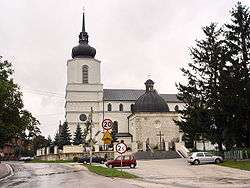 | |
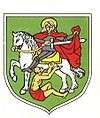 Coat of arms | |
 Pacanów | |
| Coordinates: 50°24′N 21°3′E | |
| Country | |
| Voivodeship | Świętokrzyskie |
| County | Busko-Zdrój County |
| Gmina | Gmina Pacanów |
| Area | |
| • Total | 7.13 km2 (2.75 sq mi) |
| Population (2003) | |
| • Total | 1,137 |
| • Density | 160/km2 (410/sq mi) |
| Time zone | UTC+1 (CET) |
| • Summer (DST) | UTC+2 (CEST) |
| Postal code | 28–133 |
| Area code(s) | +48 41 |
| Car plates | TBU |
| Website | pacanow |
History
Pacanów was first mentioned in a document from 1110 – 1117, issued by the Bishop of Kraków Maur, in which the erection of St. Martin's church was confirmed. At that time, the village probably belonged to a man named Siemian, who is mentioned in the document. The existence of the parish church was confirmed on August 1219 by the incumbent Bishop of Kraków Iwo Odrowąż, and in 1265, the village was granted Magdeburg rights by Prince Bolesław V the Chaste. In the same period, a number of local villages were also granted town charters (Połaniec, Nowy Korczyn, Koprzywnica and Opatowiec). The original charter of Pacanów has not been preserved, but in a document issued on February 26, 1603, King Zygmunt III Waza stated that Pacanów had been incorporated as a town since 1265.
Pacanów remained a private Bailiwick, belonging, among others, to a man named Piotr of Mokrsko and Pacanów, Castellan of Małogoszcz, (1306–1310), Wiślica (1315), and Sandomierz (1317–1328). By 1417, the town already had a parish school, and in 1433 in Nowy Korczyn, King Władysław Jagiełło recognized its Magdeburg rights, allowing a number of fairs to be held there. In 1502, during a Tatar raid, in which the invaders crossed the Vistula, Pacanów was successfully defended. The significance of the town was further enhanced when Nicholas of Cusa included Pacanów on his map of Central Europe. In 1583 and 1585 King Stefan Batory stayed there briefly. The town's prosperity came to an end during the Swedish invasion of Poland. On April 9, 1657, the town was captured by the Transilvanian army of George II Rakoczi. The invaders burned it to the ground, and that marked the decline of Pacanów, which never quite recovered its former importance.
As a result of the Partitions of Poland, having been for centuries in the Sandomierz Voivodeship, Pacanów became part of the Habsburg Empire. Between 1815 – 1915, it belonged to Russian-controlled Congress Poland. On August 24, 1813, the town was completely flooded by the Vistula river. In 1820, Pacanów had circa 1,000 residents, half of whom were Jewish. In 1869, the Russian authorities reduced Pacanów to the status of a village.
In 1928, by now in the Kielce Voivodeship of the Second Polish Republic, the population had increased to 2500, with a majority of Jewish people, who owned most local businesses and stores. When the Germans occupied the town in September, 1939, the Jewish population was around 1800, more than two-thirds of the population. Soon they were conscripted for forced, usually unpaid, labor. Jews from Radom were forced into the Jewish community resulting in a lack of housing and severe overcrowding. In April 1942, a ghetto was set up with an average of 12 or 13 people per room. Jews were not allowed into the marketplace so some local Christians smuggled food for trade. In October, 1942, some of the younger Jews were sent to labor camps, some were murdered in Pacanów, and the rest taken to the Treblinka extermination camp where they were gassed immediately.[1] The number of survivors among Pacanów's Jews is unknown.[2]
Personalities associated with the town
- Feliks Paweł Jarocki 19th century zoologist
- Kornel Makuszyński and Marian Walentynowicz, creators of
- Koziołek Matołek mythical goat-hero associated with Pacanów
Koziołek Matołek
The fictional character Koziołek Matołek, or Matołek the Billy-Goat in English, was from Pacanów and it was where his adventures were set. He was created by Kornel Makuszyński (story) and Marian Walentynowicz (art) in one of the first and most famous Polish comics back in 1933.
Once when Makuszyński and Walentynowicz were sitting in a coffee house in Kraków, they spotted a sad looking man sipping a drink at a nearby table. They asked him why he looked so gloomy, and he told them that he came from the small town of Pacanów and was wondering how to help the town prosper. Makuszyński and Walentynowicz decided then to help him by popularizing the small town in their books.
It became a cult classic, popular since its creation till today, and becoming an important part of canon of Polish children's literature. The comic has influenced many generations of Poles, and some of its phrases have penetrated into the Polish language itself, with expressions like 'w Pacanowie kozy kują' (In Pacanów, they shoe goats), 'pacan' and 'matoł' (slowpoke, dummy). Later it was made into a children's cartoon.
To this day Koziołek Matołek remains Pacanów's claim to fame, and images of him can be seen all around the village.
- Koziołek Matołek monument in Pacanów square
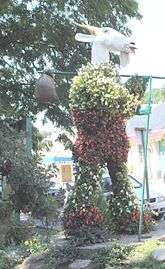 Floral monument
Floral monument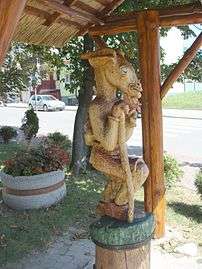 Wooden monument
Wooden monument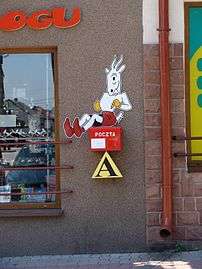 Koziołek Matołek on a post box
Koziołek Matołek on a post box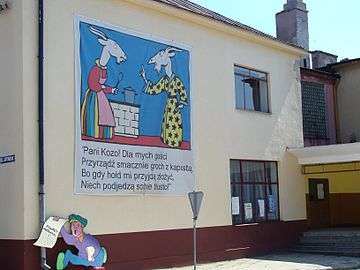 Restaurants, shops, offices, all feature Koziołek Matołek
Restaurants, shops, offices, all feature Koziołek Matołek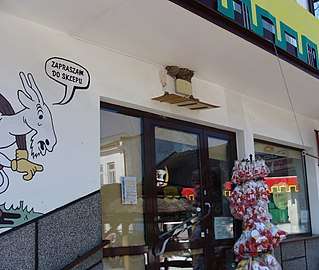 Koziołek Matołek is inviting customers into a shop
Koziołek Matołek is inviting customers into a shop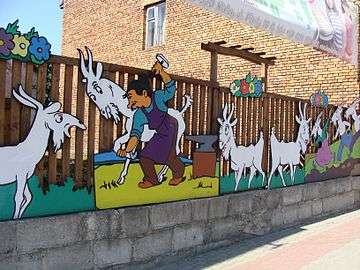 Koziołek Matołek on a road-side fence
Koziołek Matołek on a road-side fence
There exists a Fairy Tale Center in the town. [3]
References
- http://www.edwardvictor.com/Ghettos/2006/Pacanow.htm
- Megargee, Geoffrey (2012). Encyclopedia of Camps and Ghettos. Bloomington, Indiana: University of Indiana Press. p. Volume II 273-275. ISBN 978-0-253-35599-7.